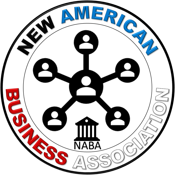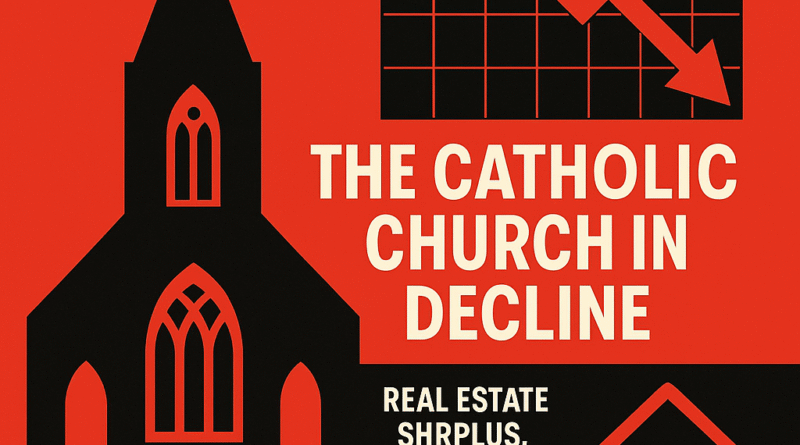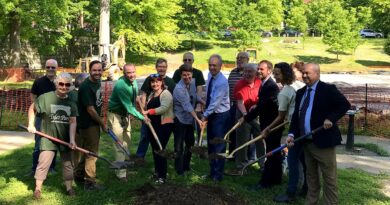The Catholic Church in Decline: Real Estate Surplus, Shrinking Clergy, and the Urgent Need for Adaptive Reuse in Louisville
From Pews to Purpose: Declining Catholic Participation and the Untapped Value of Church-Owned Properties in Louisville
The Archdiocese of Louisville spans 24 counties with about 200,000 Catholics in ~110 parishes and missions. Over the past decades it has closed or merged many parishes as membership fell. For example, Christ the King Church (West Louisville) dwindled to just 59 members and closed in 2025 when repairing its aging 1927 facility became unsustainable. In general, American Catholic parishes have seen steep declines in attendance – only about one‐third of U.S. Catholics now attend weekly Mass versus ~45% two decades ago – and similar giving shortfalls. Kentucky’s Archdiocese reports 122 diocesan priests today, far fewer than the 278 in 1970, forcing more shared pastoral assignments. In short, many church properties (churches, schools, rectories, convents) are only partially used or vacant, as archdiocesan leaders acknowledge “aging and underutilized facilities and properties” among their top challenges.
Adaptive Reuse Examples (Churches → Community Uses)
Historic churches are already being repurposed for social services nationwide. For instance, Louisville’s own St. Joseph Cathedral repurposed its unused 1866 parish school into the St. Joseph Family Community Clinic serving underserved patients. In Chicago, the former St. Vitus Church (closed 1990) became the Guadalupe Family Center, a daycare and community center serving thousands of local children. Another Chicago case – All Saints–St. Anthony Church – is being converted into an adult day-care center and a children’s daycare (see image below). These adaptive projects often required zoning changes (e.g. this site was rezoned from limited manufacturing to neighborhood commercial to allow the daycare use).
Many older churches nationwide have been repurposed for community needs. For example, Chicago’s All Saints–St. Anthony Church is being converted into an adult day-care center and a children’s daycare. This adaptive reuse required rezoning from industrial to commercial to permit the new uses.
Other examples include congregations partnering to create affordable housing. In 2002 a Louisville parish donated land to build a 24‑unit affordable senior apartment complex with Catholic Charities and other partners. Catholic Charities nationwide often uses HUD and similar grants for such projects: for example, in the 2000s Louisville’s Catholic Charities converted former parish school buildings into senior housing under HUD’s Section 202 program. Underutilized religious buildings have also been adapted to aid vulnerable groups: in Philadelphia a former convent became the SSJ Newcomer Housing Alliance (a transitional home for immigrant men); in Cincinnati a faith-based nonprofit (The Serenelli Project) is restoring a closed church to provide supportive housing for men reentering society.
Immigrant-focused reuse is particularly aligned with Catholic social teaching. Louisville’s own Vietnamese St. John Vianney parish remains vibrant (∼900 members) and not available for repurposing, but other shrinking parishes could serve as “immigrant hubs.” Existing agencies like Catholic Charities’ Migration & Refugee Services (MRS) and Kentucky Refugee Ministries already resettle newcomers—providing housing, legal aid, job placement and ESL instruction—so a church-based center could house and streamline those services. Similarly, the Catholic-sponsored Sister Visitor Center in West Louisville runs a food pantry and basic assistance programs in a former church building, showing how sacred spaces can serve neighbors in need.
Funding Sources for Church Conversions
Adaptive reuse projects typically blend public and private funding. Federal housing grants and subsidies are key: HUD’s Section 202 (senior housing) and HOME/ARP funds can underwrite affordable apartments, as can Low-Income Housing Tax Credits (LIHTCs). In NABA’s own “Love Housing” model, donated land plus LIHTCs and Section 8 vouchers finance mixed-income senior housing. For day-care or health clinics, state/federal programs (e.g. HHS Child Care and Development Block Grants, Medicaid waivers for adult day care, or FEMA disaster grants for community shelters) may apply. Victims’ programs funded by the federal VOCA fund can support shelters or trauma services (e.g. domestic violence or human trafficking shelters). Post-pandemic, many local governments (including Louisville) received ARPA/SLFRF dollars specifically to expand housing, shelters and social services; such funds could potentially be tapped or matched for church-building renovations. Private philanthropy and community fundraisers (e.g. local foundations, diocesan capital campaigns, parish appeals) are also commonly blended in. In short, projects mix government grants (HUD, HHS, FEMA, ARPA, VOCA, etc.) with tax-credit financing and charitable funding to cover renovation and operations.
Zoning, Tax, and Legal Considerations
Reusing a church for secular social services often requires careful legal work. Local zoning may not explicitly allow a new use: for example, the Chicago daycare project needed a zoning change. Churches converting to housing or care facilities may need new certificates of occupancy, ADA retrofits, and compliance with health/building codes. Historic status is another factor: many Catholic churches are architecturally significant, so preservation commissions might impose renovation conditions. Tax status must be addressed: if the facility is leased to a nonprofit provider (Catholic Charities, NABA-led non-profit, etc.), it can remain tax-exempt; the Austin example structured the redevelopment as a new school (tax-exempt). If the Archdiocese simply donates the property to another nonprofit (as it did gifting Christ the King’s site to Simmons College), the building stays on the tax rolls under the new use (often still tax-exempt if used by a nonprofit college). Another legal point is the federal Religious Land Use and Institutionalized Persons Act (RLUIPA), which protects religious institutions from unduly burdensome zoning laws. That can actually help a church owner by limiting onerous local restrictions on reusing its property. Overall, early engagement with city planners and preservation experts is critical to anticipate needed rezoning, permits or variances.
Collaborative Business Model and Sustainability
The proposed model relies on a long-term partnership: the Church provides the asset (via donation or a \$1/year lease), while NABA (with Catholic Charities, KRM and City support) manages redevelopment and services. This aligns with the Catholic mission – as Archbishop Fabre noted in Christ the King’s case, entrusting closed church property to a Black college “advances the common good” – and leverages the Archdiocese’s large real-estate holdings for social purpose.
Financially, sustainability comes from combining revenue streams. Some housing or day-care slots can be subsidized (e.g. senior units under Section 202 or Section 8, refugees on government resettlement grants, Medicaid reimbursements for adult day care, sliding‐scale fees, etc.); mixed-income tenants or clients (moderate‐income seniors, church-event rentals, café or retail space) can pay more. For example, NABA’s senior housing plan mixes 30% market-rate elders with subsidized seniors, using full rents from some to help cover costs. On-site programming can tap student or volunteer labor (as in NABA’s beauty-school partnership or Louisville’s medical programs) to reduce staffing costs. Catholic Charities and KRM bring existing programs and federal budgets; the City and state can contribute through existing contracts (e.g. refugee grants, Medicaid waivers, social service block grants) or new appropriations (like ARPA funding for homeless/immigrant support). In sum, a blend of earned income (fees, rent), public funding (HUD/HHS grants and vouchers), and philanthropy/donations can cover operations and debt service, while the Church’s low-cost capital (donated land/buildings) keeps overhead minimal.
Mission alignment is ensured by involving all parties in governance. For example, Catholic Charities will operate core services (social case management, food/clothing banks, legal help) consistent with Catholic Social Teaching (“welcoming the stranger” and feeding the hungry). NABA’s leadership (a local immigrant community leader) ensures the project addresses immigrant and minority needs, while the Archdiocese retains spiritual input (mass space, chaplaincy or volunteers, blessing the mission). This coalition can also market the project’s positive impact: drawing in grants aimed at equity, demonstrating returns (e.g. cost savings by reducing homelessness/ER visits), and tapping volunteers/supporters from both faith and civic communities.
Actionable Steps and Proposal Options
To make this collaboration feasible and attractive, the following steps and options are recommended:
- Inventory and Feasibility: Map underused Archdiocesan properties (churches, schools, rectories, convents). Assess structural condition, occupancy, and community needs nearby. Prioritize sites (e.g. Christ the King as a proved model, or other closing/upcoming closures). Proposals: Commission an independent feasibility study (building engineer, community needs assessment). Seek community input (parishioners, neighbors) through listening sessions.
- Form Partnerships: Establish a steering group with Archdiocese reps, NABA leadership, Catholic Charities/KRM directors, and city officials (e.g. Mayor’s housing office). Draft Memoranda of Understanding: e.g. Archdiocese donates building or leases it at nominal cost; NABA (or a formed nonprofit) leads development; Charities/KRM deliver services on-site.
- Legal/Zoning Work: Engage city planning early. Apply for any required rezoning or variances (like Chicago example). If the project is in a historic district, consult local historic commission. Arrange for tax-exempt status (file as nonprofit use). If property is donated, ensure deed restrictions align with mission (e.g. include requirement it serve community/social use).
- Secure Funding: Prepare joint funding applications. Possible sources: HUD grants (HOME-ARP, Section 108 for development; CDBG for planning), LIHTC equity for housing, FEMA hazard mitigation (for safe rooms), state VOCA or Violence Against Women Act grants (if housing DV victims), HHS funds for elder/child care, VA or local bonds for senior housing. Ask the City to allocate ARPA or Housing Trust Funds. Engage philanthropic support (diocesan capital campaign, local foundations, corporate donors). Illustrate how donated asset lowers capital need, making funding requests more competitive.
- Program and Revenue Plan: Define the service mix – e.g. an adult day care operating weekdays; a childcare facility; refugee welcome center with case managers; meeting space for nonprofits; café/Thrift store. Calculate budgets: project revenue (fees, payments for services) vs costs. Consider “cross‐subsidy”: moderate-income residents/clients paying market or near-market rents to subsidize sliding-scale clients (as in NABA’s mixed-income model). Explore earning ancillary income (rent event space, commercial lease of part of building, training programs).
- Construction/Renovation: Develop plans that minimize cost (lean design, reuse as-is where possible). Pursue grants for specific upgrades (e.g. ADA, energy efficiency, kitchen equip). Involve volunteers and church labor crews for some rehab work (common for nonprofit housing projects). Where feasible, include multipurpose rooms (for both Catholic devotions and community meetings) to honor the sacred origin.
- Outreach and Buy-In: Market the vision to parish communities (focus on mission continuation rather than loss of building). Emphasize how assets will continue to serve human needs (food, shelter, care) in the church’s spirit. Garner support from city stakeholders (mayoral social service advisors, local legislators) by aligning with city goals (homelessness reduction, immigrant integration). Use the Christ the King/Simmons model as a precedent for goodwill.
- Pilot and Scale: Start with a pilot campus (perhaps the most pressing or simplest site), demonstrate success, then replicate. For example, begin by converting one small parish hall into a shelter or daycare, then expand as momentum and funding grow. Document outcomes (clients served, jobs created) to attract further investment.
These steps – property audit, partnership agreements, funding strategy, and phased development – form a clear blueprint. By coupling the Church’s underused real estate with NABA’s entrepreneurial leadership and the service capacity of Catholic Charities/KRM, the model can yield ongoing revenue (grants, program fees, modest rents) and fulfill shared missions. In this way the Archdiocese honors its stewardship role by turning “irreplaceable historic structures” into vibrant community resources, benefitting immigrants, seniors, homeless individuals and the city at large.
Sources: Archdiocesan reports and news on parish closings; Catholic Charities program descriptions; adaptive reuse case studies and national analyses; NABA planning documents; demographics and attendance surveys, etc. (All insights are drawn from these sources.)
REFERENCES
Archdiocese of Louisville. (2023). Parishes. Retrieved from https://www.archlou.org/parishes/
Archdiocese of Louisville. (2022). Archdiocese Annual Report 2021–2022. Retrieved from https://www.archlou.org/wp-content/uploads/2022/11/Annual-Report-2022.pdf
Archdiocese of Louisville. (2023, April 17). Archdiocese gifts Christ the King Church to Simmons College. Retrieved from https://www.archlou.org/2023/04/17/archdiocese-gifts-christ-the-king-church-to-simmons-college/
Catholic Charities of Louisville. (n.d.). Migration and Refugee Services. Retrieved from https://cclou.org/migration-and-refugee-services/
Catholic Charities of Louisville. (n.d.). Sister Visitor Center. Retrieved from https://cclou.org/sister-visitor/
Center for Applied Research in the Apostolate. (2023). Frequently requested Church statistics. Georgetown University. Retrieved from https://cara.georgetown.edu/frequently-requested-church-statistics/
City of Chicago Department of Planning and Development. (2023). Zoning Board of Appeals—Meeting Minutes. Retrieved from https://www.chicago.gov/city/en/depts/dcd/supp_info/zoning_board_ofappeals.html
Chicago Tribune. (2022, August 30). Old church reborn as day care center in Pilsen. Retrieved from https://www.chicagotribune.com/news/breaking/ct-pilsen-church-daycare-20220830-ynk6okn6mvb5xky4eevlmsqa6e-story.html
Guadalupe Family Services. (n.d.). About. Retrieved from https://guadalupefamilyservices.org/
HUD Exchange. (2023). HOME-American Rescue Plan Program. Retrieved from https://www.hudexchange.info/programs/home-arp/
HUD.gov. (n.d.). Section 202 Supportive Housing for the Elderly Program. Retrieved from https://www.hud.gov/program_offices/housing/mfh/progdesc/eld202
Kentucky Refugee Ministries. (n.d.). About Us. Retrieved from https://kyrm.org/about-us/
Louisville Metro Government. (2023). Office for Globalization. Retrieved from https://louisvilleky.gov/government/globalization
National Catholic Reporter. (2023, May 1). U.S. Catholic priest shortage hits home. Retrieved from https://www.ncronline.org/news/us-catholic-priest-shortage-hits-home
National Low Income Housing Coalition. (2023). The Gap: A Shortage of Affordable Homes. Retrieved from https://nlihc.org/gap
Pew Research Center. (2021). Faith among U.S. Catholics continues to decline. Retrieved from https://www.pewresearch.org/fact-tank/2021/03/17/u-s-catholics-open-to-women-priests-but-strongly-oppose-ending-celibacy-requirement/
Simmons College of Kentucky. (2023). Historic Gift of Church Property. Retrieved from https://simmonscollegeky.edu/news/historic-gift-of-church-property/
The Serenelli Project. (n.d.). Our Mission. Retrieved from https://theserenelliproject.org/
U.S. Department of Health and Human Services. (n.d.). Older Americans Act (OAA). Retrieved from https://acl.gov/about-acl/authorizing-statutes/older-americans-act
U.S. Department of Health and Human Services. (n.d.). Child Care and Development Fund (CCDF). Retrieved from https://www.acf.hhs.gov/occ/child-care-development-fund-ccdf
U.S. Department of Homeland Security. (n.d.). Emergency Food and Shelter Program (EFSP). Retrieved from https://www.fema.gov/grants/emergency-food-and-shelter-program




